HOW COLOR WORKS
Color is actually a function of the eye. It sorts wavelengths of light and makes them
visible as different colors. Mixtures of wavelengths make lighter colors.
Here is a list of frequently asked questions:
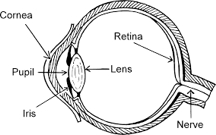 How does the eye work?
How does the eye work?
The eye is like a camera. It has the following parts:
- Cornea - A transparent protective cover for the eye parts. It also helps focus
the light.
- Iris - This is like the diaphragm of the camera controlling the amount of light
admitted.
- Pupil - This is like the aperture of the camera, letting in the light.
- Lens - This is like the lens of a camera. It focuses the image on the retina.
- Retina - This is like the film in the camera. It is sensitive to light.
- Nerve - This carries the signals of the image from the eye to the brain.
How does the retina work?
The retina is like the light sensitive part of a digital camera:
- The light comes from the left of the diagram and passes through the retina cells
to reach the cones.
- The light violet cells in the diagram are the rod cells containing rhodopsin.
They see at night in aqua light, but it is seen as white.
- The yellow cells in the diagram are blue cone cells containing cyanolabe. They are
sensitive to blue light in the 400 nm to 500 nm range.
- The magenta cells in the diagram are green cone cells containing chlorolabe. They are
sensitive to green light in the 450 nm to 630 nm range.
- The blue cells in the diagram are red cone cells containing erythrolabe. They are
actually sensitive to yellow light in the 500 nm to 700 nm range.
- The dark gray cells are horizontal cells that sharpen the edges of the image.
- The green cells in the diagram nourish the other cells.
- The light gray cells are bipolar cells that carry black and white information
- The red cells are bipolar cells that compare red and green information.
- The cyan cells are bipolar cells that compare yellow and blue information.
- The dark cyan, dark red, white, and light gray cells art the left edge are ganglion
cells that amplify the signals and send them to the brain.
- The rod and cone cells contain light sensitive proteins that are structured as shown
at right.
- The light sensitive proteins have a grid design that is resonant to one color of
light.
- Each light-sensitive protein has different amino acids at strategic points that
change the grid spacing (and the color detected).
Are the eyes of other animals the same as human eyes?
Different animals have different visual systems:
- The above retina diagram is for a human eye.
-
Most primates have the same visual systems man has. Some are missing one
primary color (either red or green).
-
Many smaller mammals have only the rods and the red and blue cones and no
green-red bipolar cells.
-
Many nocturnal animals have only rods or rods and blue cones and no color
separation bipolar cells.
- Some nocturnal animals have multiple sets of cells for night vision
as well as day vision. They see colors at night.
- Many insects have more than 3 sets of cells for different colors. Some are
sensitive to ultraviolet. And they have compound eyes.
-
Bees have 4 primary colors: green, blue, violet, and ultraviolet.
-
Many birds have color vision similar to humans. Others add ultraviolet.
- Many birds have color droplets in the cone cells, increasing the number of
colors sensed.
-
Many reptile predators see in blue and infrared. Separate sensors detect infrared.
- Other reptiles and amphibians have multiple cells for different colors.
- Some reptiles have color droplets in the cone cells, increasing the number of
colors sensed.
- Even more exotic systems are found in invertebrates. The nautilus has a
pinhole eye with no lens.
The following information applies mainly to human vision:
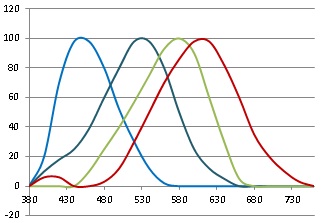 How does the retina respond to different colors of light?
How does the retina respond to different colors of light?
A computer simulation of the spectral response of this color system is shown at right.
- The rod cells appear light violet because the pigment is sensitive to green and
blue light between 400 nm and 600 nm, peaking at 510 nm. But bright light bleaches
these pigments, shutting down these cells.
- The blue cones appear yellow because the pigment is sensitive to blue light
in the 380 nm to 500 nm range, peaking at 430 nm.
- The green cones appear magenta because the pigment is sensitive to green light in
the 450 nm to 630 nm range, peaking at 530 nm.
- The red cells appear blue because they are actually sensitive to yellow light in
the 500 nm to 700 nm range, peaking at 560 nm.
- The red cells respond to red light because the difference between the red cone
output and the green cone output determines the scale between red and green.
|
The main colors of spectral light (with wavelength and frequency) are:
| | Wavelength | Frequency |
Color | Red Cone | Green Cone | Blue Cone |
| | 400 nm | 750 THz |
violet | half | none | high |
| | 460 nm | 650 THz |
blue | none | none | high |
| | 520 nm | 610 THz |
cyan | none | high | high |
| | 520 nm | 580 THz |
green | none | high | none |
| | 570 nm | 530 THz |
yellow | high | high | none |
| | 590 nm | 510 THz |
orange | high | half | none |
| | 670 nm | 450 THz |
red | high | none | none |
|
Nonspectral colors are also produced:
| |
Color | Red Cone | Green Cone | Blue Cone |
| |
white | high | high | high |
| |
gray | half | half | half |
| |
black | none | none | none |
| |
magenta | high | none | high |
| |
pink | high | half | half |
| |
brown | half | low | none |
| |
olive | low | half | none |
|
Every color appears on this color map or a darker version.
See larger version below.
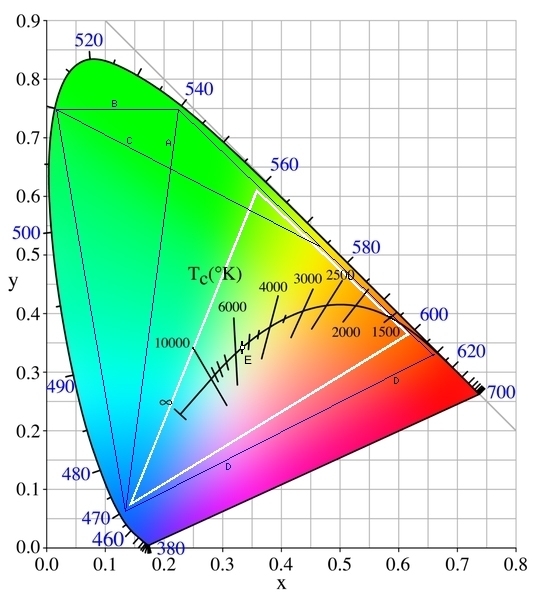
|
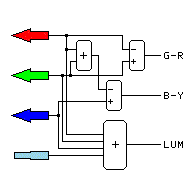 How does the retina encode color?
How does the retina encode color?
The retina uses an analog matrix to encode color detected by the cone cells:
- The brightness of the light is measured by sending the outputs of all light sensitive
cells to a bipolar cell that combines them.
- A second set of bipolar cells combines the red and green signals into a yellow signal
used below.
- A third set of bipolar cells compare the strength of the blue and yellow
signals and reports the differential output between them as blue-yellow.
- Another set of bipolar cells compare the strength of the green and red
signals and reports the differential output between them as green-red.
- An alternate possibility is that the blue-yellow difference is obtained with only the
red cones (sensitive to yellow) and the blue cones.
These matrix encoders are placed over most of the surface of the retina so different
objects appear different colors.
- The fovea (point of central vision) contains mostly red cones, but with just enough of
the other cones to identify color. It contains no rods.
- A ring around the fovea has all 4 kinds of cells in equal proportions, with the full
three-color encoding.
- A ring around that area does not contain the green-red encoders.
- Peripheral vision (the rest of the eye) contains only rods and detects mostly motion.
COLOR MATRIX OUTPUTS
| | yel | − | mid |
+ | blu | |
| grn | | |
| |
| grn |
| + | | |
| |
| + |
| mid | | |
| |
| mid |
| − | | |
| |
| − |
| red | | |
| |
| red |
| | yel | − | mid |
+ | blu | |
|
How the brain interprets the matrix:
- The horizontal axis of the table shows the output of the blue-yellow bipolar cell for the
color being looked at.
- The vertical axis of the table shows the output of the green-red bipolar cell for the
color being looked at.
- The output of the brightness bipolar cell for the color being looked at determines how dark
the color is.
- The brightness is not shown in the table at left. Its axis would be perpendicular to the
screen.
- Any color can be described as the three outputs of the matrix: brightness, blue-yellow,
and green-red.
- The color matrix assures that the same color seen under many conditions appears to
be nearly the same.
- The outer periphery of vision is usually black and white and out of focus. It notices
movement.
- Psychological primaries are 4 points where one differential output is centered while the
other is at an extreme.
- Psychological primaries have no use other than psychological effects. Colors cannot be
mixed with them.
- Other primaries are used to mix colors.
- The NTSC US color TV system (1953-2007) used the diagonals of the eye matrix
to hide signal errors.
|
PSYCHOLOGICAL
PRIMARIES |
|---|
| | Cerise |
| | Yellow |
| | Aqua |
| | Blue |
| separator |
|---|
NTSC COLOR TV
PRIMARIES |
|---|
| | Vermillion |
| | Lime |
| | Sky |
| | Purple |
|
 Why can't I see color at night?
Why can't I see color at night?
The retina contains three different kinds of light sensitive cells that work in
daylight, but only one kind of cell that works at night:
- The red, green, and blue cones work only in the daylight. They go silent when only
very low levels of light strike them.
- The rods work only at low light levels. They are mostly bleached out by light when
light levels are too bright for them.
- Rod cells do detect edges at the periphery of vision in daytime or nighttime.
- Brightness is measured from all light sensitive cells by bipolar cells that
combine the signals to measure intensity.
- Since the rods feed only the bipolar cells that measure light intensity, their output
is seen as white even though they do not detect red light.
- Since rod cells take time to gain sensitivity, night vision takes time to work
after suddenly leaving a bright area. It takes about half an hour.
- Night vision does not work while someone is driving a vehicle. Headlights and
signals give off enough light to bleach out the rods.
- Note that any light bright enough to activate a cone cell will activate it in the
dark, so color is often seen from distant lights.
- There are no rods in the fovea (center of vision). Viewing something directly
at night makes it indistinct. Look slightly to one side to see it.
 What are primary colors?
What are primary colors?
Primary colors are sets of colors that can be used to mix all of the other colors.
The primary colors depend on the kinds of color preceptors present.
Then number of primary colors depends on the number of types of color preceptors.
Why are there three primary colors?
There are three primary colors because there are three kinds of color vision cones in the
human retina.
Primary colors are chosen to differentially activate the three kinds of cones to mix many
different colors.
The better the choice of primary colors, the larger is the gamut of colors that can be
mixed with them.
Do animals have primary colors?
If they have color vision, they have primary colors.
Since animals do not try to mix colors, they don't know or need to know about primary
colors.
Why are there several different sets of primary colors?
The primary colors in these different sets are used for different purposes:
| The primaries of light are used for mixing colored lights.
The light primaries are
RED,
GREEN, &
BLUE.
|

|
These are the colors where each retinal pigment is most isolated from responses
of the other two pigments. Varying these primaries gives the largest possible gamut of colors
from using three primaries.
These primaries are used for producing light sources, stage lighting, color photography,
color television, separated dots of pigment, and mixing colors on rotating discs.
These are additive primaries because they work toward white when mixed.
|
| The primaries of pigments are used for mixing transparent paints and dyes.
The pigment primaries are
MAGENTA,
YELLOW, &
CYAN.
|

|
These are the colors where each pigment removes the most of one of the light
primaries without removing much of the other two primaries. Varying these primaries gives
the largest possible gamut of colors from using three primaries.
These primaries are used for transparent dyes, water colors, color printing, photographic
prints, paint mixing, and photography color filters.
These are subtractive primaries because they work toward black when mixed.
|
| The primaries of oils are used for mixing oil paints.
The oil primaries are
RED,
YELLOW, &
BLUE.
|

|
These colors work for oil paints, because they have unique properties that other
color media do not have. They do not work with other kinds of color mixing.
These are part additive and part subtractive because they behave differently at different
concentrations.
|
| Quattron primaries for TV sets.
The Sharp Quattron TV primaries are
RED,
YELLOW,
KELLY, &
BLUE.
|

|
This is an attempt to increase the gamut of colors a standard color display can
make.
What it does is allow the green to make a better cyan by taking the job of making yellow away.
Since it uses a standard TV signal, it just adjusts the colors produced.
|
| AutoVary primaries for TV sets.
The Autovary primaries are
RED,
LEAF,
KELLY, &
BLUE.
|

|
This is an attempt to increase the gamut of colors a standard color display can
make.
What it does is allow the green to make a better cyan by shifting it between leaf and kelly
depending on the decoding angle of the color signal.
Since it uses a standard TV signal, it just adjusts the colors produced.
|
| Psychological primaries can't mix colors.
The psychological primaries are
CERISE,
YELLOW,
AQUA, &
BLUE.
|
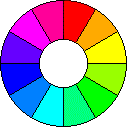
|
These are used only for human vision experiments. They have no value for mixing
colors.
Notice that these colors are at right angles to each other on the color wheel (below).
|
What is the color map?

Color Map
The color map is a map of the gamut of all possible colors the eye can see.
Note the colors on this screen are approximate.
What are the spaces outside the curve?
These are colors the eye cannot see because they would require stimulating the cone cells
individually rather than all at the same time.
What are the numbers around the edge of the map?
They are the wavelengths in nanometers of the colors at those points.
Why are there no wavelength values along the bottom edge?
The colors there are nonspectral colors. They are mixtures of sets of spectral colors, as
are all of the colors in the interior of the map.
What are the numbers along the x axis?
The x axis is the portion of the total stimulation received by the eye that is red.
What are the numbers along the y axis?
The y axis is the portion of the total stimulation received by the eye that is green.
Where are the numbers for blue stimulation?
The z axis is perpendicular to the page. On the top surface of the map, the values are
x + y + z = 1.
What about darker colors?
These are on layers under the map visible here where x + y + z = t and t is a value between
0 and 1. See below.
What is the curved line across the center of the map?
This is the line of colors produced by black body radiation. The numbers are the black body
temperatures in Kelvins.
What is the point marked E on the map?
This is the equal energy point where red, green, and blue are equal at 5500 K.
x = 1/3, y = 1/3, and z = 1/3.
What is the triangle containing segments A and D?
This is the gamut of colors displayed on a color TV or monitor. All colors outside this
triangle are displayed wrongly on this screen.
What is the white triangle?
This is the gamut of colors visible under a white LED lamp.
What is the quadrilateral containing segments B and D?
This is the gamut of colors displayed on an Autovary color TV or monitor.
What is the quadrilateral containing segments C and D?
This is the gamut of colors displayed on a Quattron color TV or monitor.
What is the isometric color map?
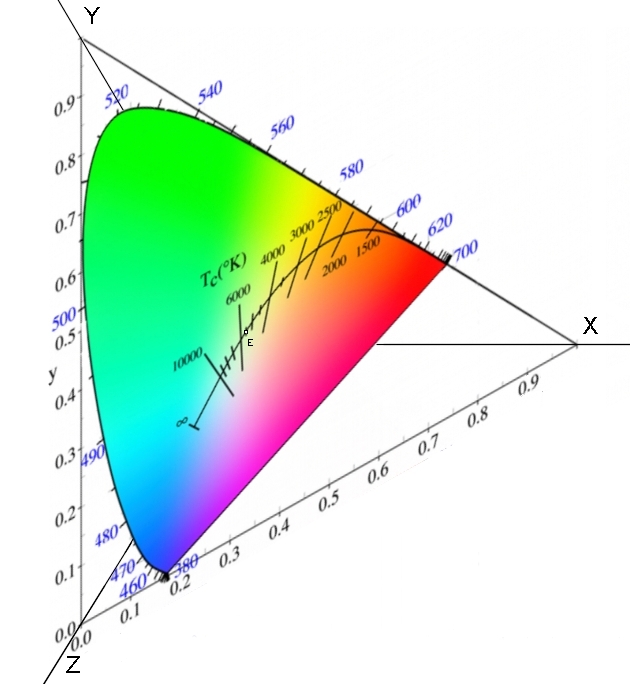
Isometric Color Map
The isometric color map is the map of the gamut of all possible colors the eye can see.
The isometric color map is shown so that all three axes are visible.
This is the same map as above, but shown over the isometric view point instead of over the
Z axis.
Again, only the top layer where x + y + z = 1 is visible.
What is the triangle around the map?
This is the limit of the area where x, y, and z are all simultaneously nonnegative.
What are the other features of the isometric color map?
The spaces outside the colored space are colors the eye cannot see.
- This is because they would require stimulating cone cells individually rather
than collectively.
Numbers around the curved map edge are wavelengths in nanometers of colors at those
points.
Colors along the straight edge of the map and in the map interior are nonspectral colors.
- They are mixtures of sets of spectral colors.
Numbers along the diagonals are portions of the total cone stimulation projected
from x and y axes.
Darker colors are on layers under the visible map where x + y + z = t and t is between
0 and 1. See below.
What is the curved line across the center of the map?
This is the line of colors produced by black body radiation.
- The numbers are the black body temperatures in Kelvins.
Notice that the equal energy point E where red, green, and blue are equal is at 5500 K.
- In this view, it is closest to being over the origin of the graph.
Why is the red end of the spectrum not at a corner?
Both the red and the green cone are stimulated at the red end of the spectrum.
Why is the blue end of the spectrum not at a corner?
Both the blue and the red cone are stimulated at the blue end of the spectrum.
Why is the green part of the spectrum not at a corner?
The green cone is never stimulated alone. Red and blue cones are stimulated at all green
wavelengths.
Why are multiple cones stimulated at the ends of the visible spectrum?
The ends of the spectrum are the limits where the cornea and lens stop passing light.
What does it mean where the colored area touches the triangle?
It means that one cone is receiving very little stimulation.
- This happens on a line between red and yellow, at aqua, and at violet.
What is the 3-D color map?
The 3-D color map shows the darker layers underneath the usual map.
The diagram shows the full strength, 2/3, 1/3, and 1/12 bright colors.
There are infinite layers between black at the bottom and the regular map.
The closer a layer is to the bottom, the darker the colors are.
The leftmost diagram shows how the layers infinitely stack together.
Black is at {0,0,0} at the lower left corner.
Red (x) cone alone is at {1,0,0} at the lower right corner.
Green (y) is at {0,1,0} at the top corner.
Blue (z) is at {0,0,1} at the lower front corner.
Every possible visible color is present in this map.
| What is the old color wheel?
The old color wheel is based on using the oil paint primaries as the basis of color.
|
|
The oil primaries are:
RED
YELLOW
BLUE
|

|
What is wrong with using the old color wheel?
It does not cover the entire gamut of visible hues. Colors are subdued.
It works for only oil colors.
It does not contain all of the scientific primaries.
|
| What is the new color wheel?
The new color wheel is based on the scientific primaries of light and of pigment.
|
|
The light primaries are:
RED
GREEN
BLUE
|
The pigment primaries are
MAGENTA
YELLOW
CYAN
|

|
What is right with using the new color wheel?
It covers the entire gamut of visible hues. Colors are vivid.
It works for all color mixing except oil paint.
It does contain all of the scientific primaries.
Complementary colors are actually on opposite sides of the wheel.
|
Why is there a color wheel when the spectrum is a straight line?
|
Notice the following:
- The red cone has a secondary peak at violet.
- Color map violet has a positive x (red response).
- The green-red bipolar cell thus sees violet as red.
- Thus, violet is on the red side of the color matrix.
- The color matrix has a range for violet thru cerise.
- The color matrix has colors encircling white.
- The eye sees magenta as red and blue mixed.
- Cerise, magenta, and purple fill the matrix gap.
|
| LIM | GRN |
AQU | CYN |
SKY |
| LEF | +LIM |
+AQU | +SKY |
AZU |
| YEL | +YEL |
WHT | +BLU |
BLU |
| ORN | +VER |
+CER | +PUR |
VIO |
| VER | RED |
CER | MAG |
PUR |
|
|
How is an equally spaced color wheel made from the color matrix?
|
Like this:
|
| | GRN |
AQU | CYN |
|
| LEF | |
| |
AZU |
| YEL | |
WHT | |
BLU |
| ORN | |
| |
VIO |
| | RED |
CER | MAG |
|
|
With these
equally
spaced
primary
colors:
|
| | GRN |
| CYN |
|
| | |
| |
|
| YEL | |
WHT | |
BLU |
| | |
| |
|
| | RED |
| MAG |
|
|
Rounding
off of
the first
diagram:
|
|
Which is
just a
rotation
of the new
color wheel
diagram
used on
this site:
|
|
How are colors mixed?
|
What is additive color mixing?
Additive color mixing combines colored light together.
The additive color mixing result is lighter.
Additive color mixing uses the primary colors of light.
All primaries in equal amounts mix to make white.
Complementary colors mix to make white.
|

|
+
=
+
=
+
=
+ +
=
|
+
=
+
=
+
=
+
=
+
=
+
=
|
+
=
+
=
+
=
+
=
+
=
+
=
|
+
=
+
=
+
=
+ +
=
+ +
=
+ +
=
|
+
=
+
=
+
=
+ +
=
|
|
What is subtractive color mixing?
Subtractive color mixing combines colored filters together.
The subtractive color mixing result is darker.
Subtractive color mixing uses primary colors of pigments.
All primaries in equal amounts mix to make black.
Complementary colors mix to make black.
|

|
+
=
+
=
+
=
+
+
=
|
+
=
+
=
+
=
+
=
+
=
+
=
|
+
=
+
=
+
=
+
=
+
=
+
=
|
+
=
+
=
+
=
+ +
=
+ +
=
+ +
=
|
+
=
+
=
+
=
+ +
=
|
 What are complementary colors?
What are complementary colors?
Complementary colors are colors that mix additively to produce white.
- The complementary color of any hue is the hue that combines additively with it to
produce white.
- Colors diagonally opposite to each other on the color matrix table are complements.
- Colors diagonally opposite to each other on the new color wheel are complements.
- Colors at opposite ends of a line passing through the equal energy point E on the color
map are complements.
- The complement of a light primary is that color which absorbs the light primary without
absorbing other colors. This is a pigment primary.
- On the light and pigment primary diagrams, complements are on opposite sides of
white.
-
One light primary and the opposite pigment primary are complements.
- One light primary and the opposite light secondary are complements.
- One pigment primary and the opposite light primary are complements.
- One pigment primary and the opposite pigment secondary are complements.
- The diagonally opposite colors on the old color wheel are NOT complementary.
- The light secondaries are the pigment primaries.
- The pigment secondaries are the light primaries.
Do some people have eyes different from the eyes of most people?
 Yes. There are several genetic differences in the eyes of some people.
Yes. There are several genetic differences in the eyes of some people.
The color wheel at right shows some of the defects (outside ring is normal).
The following are forms of color vision defects:
- Protanopia - the red-sensitive pigment is missing or inactive
(second ring from outside).
- Deutanopia - The green-sensitive pigment is missing or inactive
(second ring from inside).
- Tritanopia - The blue-sensitive pigment is missing or inactive
(inside ring).
- Tetartanopia - Undocumented disease with a loss of sensitivity to yellow. There are
two possibilities:
- A failure of the yellow-blue bipolar cells.
- A disease predicted by the Hering Opponent Color Theory that does not exist.
- Protanomaly - The red sensitive cells are sensitive to leaf green (yellow green)
instead of red.
The person sees full color, but some oranges, yellows, greens, and browns are seen
as wrong colors.
- Deutanomaly - The green sensitive cells are sensitive to yellow instead of green.
The person sees full color, but some oranges, yellows, greens, and browns are seen
as wrong colors.
- Tritanomaly - The blue sensitive cells are sensitive to cyan instead of blue.
The person sees full color, but some magentas, violets, blues, cyans, and greens
are seen as wrong colors.
- Red-Green Indistinction - The green-red bipolar cells are not working. There are no
sensitivity changes.
- Red-Green anomaly - Both the red sensitive cells and the green sensitive cells respond
to wrong colors.
The person has protanomaly and deuteranomaly.
- Cone Monochromatism - Only the blue sensitive cells and the rods work.
The person sees black and white. Green and yellow appear dark, and red appears black.
- Rod monochromatism - Only the rods work.
The person sees in black and white. Reds appear black. The person can not see in
bright light.
- Notice that protan and deutan defects make the green-red bipolar cells quit or
malfunction.
- Notice that tritan defects make the blue-yellow bipolar cells quit or
malfunction.
The following are forms of undocumented color vision supposedly found only in human women:
- Protanbianomaly - Some red sensitive cells are sensitive to leaf green (yellow green)
and others to red.
The person sees full color, but some oranges, yellows, greens, and browns are seen
as wrong colors.
- Deutanbianomaly - Some green sensitive cells are sensitive to yellow and others to green.
The person sees full color, but some oranges, yellows, greens, and browns are seen
as wrong colors.
- Protatetrachromacy - Some red sensitive cells are sensitive to leaf green (yellow green)
and others to red.
Bipolar cells differentiate between them.
The person sees full color, but some oranges, yellows, greens, and browns are seen
as wrong colors.
The person can distinguish colors that other people see as identical.
- Deutatetrachromacy - Some green sensitive cells are sensitive to yellow, and others to green.
Bipolar cells differentiate between them.
The person sees full color, but some oranges, yellows, greens, and browns are seen
as wrong colors.
The person can distinguish colors that other people see as identical.
This is covered in more detail at Human Color Vision Defects.
Can some people with defective color vision do something about it to see more
normally?
Yes. There are several tricks to see more colors:
- Those with protanomaly, deutanomaly, tritanomaly, or red-green anomaly can use any of the
following tricks:
- Special glasses:
- Special notch filters remove spectral yellow and spectral cyan from light seen by viewers.
The illumination must contain the colors the filters pass.
- The colors seen here are the same colors seen on a color TV screen.
- The glasses must be removed when driving under rare low-pressure sodium street lights.
- A company named EnChroma makes these glasses.
- Special lights:
- This special lamp must emit only red, green, and blue light, but no other colors.
- The lamp can contain separate bulbs for red, green, and blue or a tricolor
(red, green, blue) LED.
- A tricolor television screen or computer monitor showing a white screen will work.
A Quattron screen will not work.
- Other light sources in the area destroy the effect.
- Making a special light is covered at
Build a Special Vision Light.
- Photography and Television
- Color separation in photography and color TV divides light into red, green, and blue.
- A TV set, a camera screen, or a monitor gives off red, green, and blue. A Quattron 4-color
screen can NOT be used for this.
- The cyan-magenta-yellow printing process may or may not work with individual people. It does
work with the glasses above.
- A TV camera image shown on a TV set can be used to see colors correctly.
In each case above, the person usually sees colors that normal people see, but is not used
to them, so the person must learn them.
The above will NOT work for protanopia, deuteranopia, tritanopia, red-green indistinction,
or total color blindness.
- Those with missing color sensors (protanopia, deutanopia, tritanopia, red-green indistinction,
or monochromatism) need more drastic remedies:
- Special glasses:
- Use flip-down lenses, rotatable color filters, or tinted glasses lenses.
- A red lens and a green lens (or a magenta lens and a cyan lens) for protan or deutan
defects.
- A yellow lens and a blue lens for tritan defects.
- A red, a green, and a blue lens (or a magenta, a yellow, and a cyan lens) for
monochromatic defects.
- Different colors in left and right lenses sacrifice depth perception for
color differentiation.
- Colored lights:
- Shine colored lights on objects to help discern their colors. Choose lamp color for
the type of color blindness.
- Colored lights can be switched on and off to make certain colors stand out.
- Put different colored lights on opposite sides of the object.
- Use a blinking colored light or a rotating color wheel on a light to make certain
colors flash.
- Color TV camera and monitor:
- Aim the camera at the item and watch the monitor.
- Switch camera color channel outputs or use hue control on TV to see other colors.
This is covered in more detail at Human Color Vision Defects.
Links:
 How does the eye work?
How does the eye work?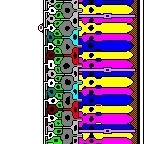
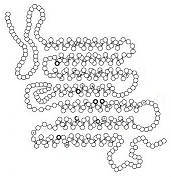
 How does the retina respond to different colors of light?
How does the retina respond to different colors of light?
 How does the retina encode color?
How does the retina encode color? What are primary colors?
What are primary colors?



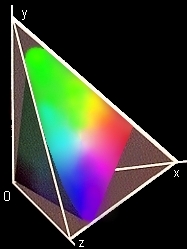
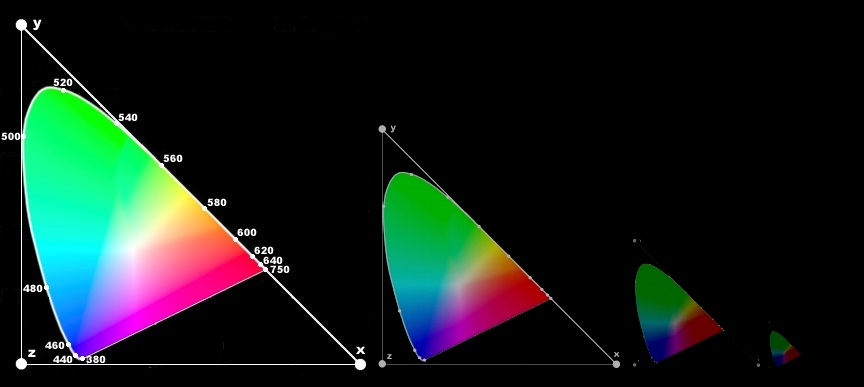

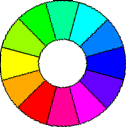





 Yes. There are several genetic differences in the eyes of some people.
Yes. There are several genetic differences in the eyes of some people.